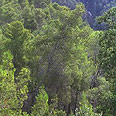
Illustration
Photo: GPO
At least one tree appears in this week’s Torah portion, B’shalach. Thirsty and feisty, the people complain to Moses at the bitter waters of Marah that they will have nothing to drink. Moses takes the matter to his Superior, and God shows Moses a piece of wood. Moses throws it, and it proves to have remarkable purifying qualities.
According to the classic midrashic collection the Mechilta, some eighteen hundred years ago the sages of the Land of Israel raised a question: What kind of wood was used to sweeten the bitter waters?
Different suggestions were offered: Rabbi Joshua thought it must have been a willow, while Rabbi Eliezer Hamodai suggested the olive, adding that it is the most bitter of trees. Presumably he thought that the tree drew away the unwanted acidity.
Rabbi Joshua ben Korcha had an even more radical suggestion. He thought that a poisonous creeper, perhaps an ivy, was planted. Other possibilities included cedar, and even a genetically modified combination of fig and pomegranate.
And for Rabbi Shimon bar Yochai, the tree to which the verse refers is no tree at all, but rather the Tree of Life, the Torah. Since the word for throwing can be connected to learning and teaching, the wordplay is particularly neat.
Importance of trees
As we mark the festival of Tu Bishvat this week, we may pause to consider what posessed our ancestors to ask such an extrardinary question. It’s worth noting that this is not the only enquiry of its kind. Elsewhere we find them asking what was the tree planted in the Garden, the fruit of which was eaten by Adam and Eve?
These examples and other like them demonstrate that for our Sages, trees were alive in a way which they rarely are for us. Each species and strain had different connotations, almost a different personality.
Tu Bishvat began as little more than a demarcation date. All fruit after this date belonged to one year, while the fruit from the day before belonged to the year before. It’s like celebrating the beginning of the tax year (although given the current investingations of the tax authorities, this may not be the best comparison).
Over time the day developed, particularly under the influence of the medieval mystics of Safed. It underwent yet another transformation in the early days of the Zionist settlement of the Land of Israel.
In our day, the festival has gained a strong environmental dimension. In the spirit of our predecessors so many generations ago, we are invited to re-create the kind of connection with the natural world which inspired our tradition. The Torah is likened to a tree. When will we make trees part of our Torah?
Rabbi Michael Marmur is the dean of the Hebrew Union College















